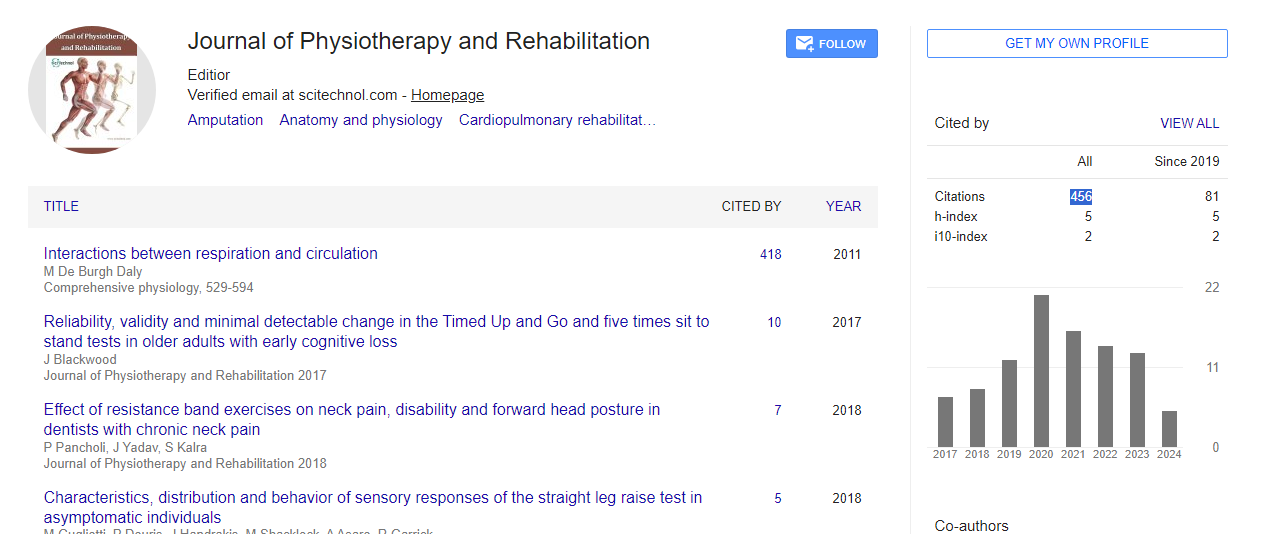Perspective, J Physiother Rehabi Vol: 8 Issue: 3
Neurological Conditions and Physiotherapy: Advancements in Rehabilitation Techniques
Eric Saleh*
1Department of Health and Rehabilitation, University of Gothenburg, Gothenburg, Sweden
*Corresponding Author: Eric Saleh,
Department of Health and Rehabilitation,
University of Gothenburg, Gothenburg, Sweden
E-mail: saleheri@c.sw
Received date: 28 May, 2024, Manuscript No. JPTR-24-140179;
Editor assigned date: 30 May, 2024, PreQC No. JPTR-24-140179 (PQ);
Reviewed date: 13 June, 2024, QC No. JPTR-24-140179;
Revised date: 21 June, 2024, Manuscript No. JPTR-24-140179 (R);
Published date: 28 June, 2024, DOI: 10.4172/JPTR.1000166.
Citation: Saleh E (2024) Neurological Conditions and Physiotherapy: Advancements in Rehabilitation Techniques. J Physiother Rehabi 8:3.
Description
Physiotherapy plays a important role in the rehabilitation of individuals with neurological conditions, leveraging advancements in treatment techniques to enhance functional outcomes and quality of life. The evolving landscape of physiotherapy in neurological rehabilitation, highlighting key advancements in techniques that are transforming care for patients with conditions such as stroke, spinal cord injury, multiple sclerosis, and Parkinson's disease.
Scope of neurological conditions
Neurological conditions encompass a broad spectrum of disorders affecting the Central Nervous System (CNS), Peripheral Nervous System (PNS), and neuromuscular system. These conditions often result in impairments such as muscle weakness, spasticity, balance deficits, sensory loss, and cognitive challenges. Physiotherapy interventions are tailored to address these impairments, promote neuroplasticity, and facilitate recovery through targeted rehabilitation techniques.
Constraint induced movement therapy is an intensive rehabilitation approach designed to improve motor function in individuals with neurological conditions, particularly stroke. CIMT involves restricting the use of the unaffected limb while engaging the affected limb in repetitive, task-specific exercises. This technique promotes cortical reorganization, enhances motor learning, and facilitates functional recovery by encouraging the use of the affected limb in daily activities.
Robot-assisted therapy integrates robotic devices, such as exoskeletons and robotic arms, into rehabilitation protocols to provide precise, repetitive movements and real-time feedback. These devices assist patients in performing controlled exercises, improving muscle strength, joint range of motion, and coordination. Robot-assisted therapy is beneficial for individuals with stroke, spinal cord injury, and other neurological conditions, offering standardized, data-driven interventions that optimize recovery outcomes.
Virtual Reality and Augmented Reality technologies are revolutionizing neurorehabilitation by creating immersive environments that simulate real-life scenarios and interactive tasks. Physiotherapists use VR and AR to engage patients in therapeutic exercises, balance training, and cognitive rehabilitation programs. These technologies enhance motivation, sensory integration, and motor planning skills, making rehabilitation sessions more engaging and effective for individuals with neurological impairments.
Functional electrical stimulation involves the application of electrical currents to stimulate paralyzed or weakened muscles, promoting muscle contraction and restoring functional movement patterns. FES can be used for gait training, upper limb rehabilitation, and spasticity management in conditions such as spinal cord injury and stroke. Advances in FES technology include adaptive systems that synchronize muscle activation with movement phases, enhancing coordination and motor control.
Task-Specific Training emphasizes repetitive practice of functional tasks relevant to daily activities, promoting skill acquisition and motor learning. Physiotherapists tailor training programs to address specific movement goals, such as walking, reaching, and balance, based on individualized assessments and functional priorities. Motor learning principles, such as variability of practice and feedback, are integrated to optimize learning and retention of motor skills over time.
Clinical applications and evidence-based practice
Clinical research supports the effectiveness of these advancements in improving functional outcomes and quality of life for individuals with neurological conditions:
Stroke rehabilitation: Studies have shown that CIMT and robot-assisted therapy significantly improve upper limb function and activities of daily living in stroke survivors, promoting greater independence and quality of life.
Spinal cord injury: Robot-assisted gait training and FES technologies enhance mobility, muscle strength, and cardiovascular fitness in individuals with spinal cord injury, enabling greater participation in community activities and reducing secondary complications.
Parkinson's disease: Exercise-based interventions, including virtual reality and aerobic training, mitigate symptoms of Parkinson's disease, such as gait disturbances and balance impairments, while promoting neuroprotective effects and enhancing overall well-being.
Conclusion
Advancements in rehabilitation techniques have transformed the landscape of physiotherapy for individuals with neurological conditions, offering innovative solutions to address impairments, promote neuroplasticity, and optimize recovery outcomes. By leveraging CIMT, robot-assisted therapy, virtual reality, functional electrical stimulation, and motor learning principles, physiotherapists empower patients to regain independence, improve quality of life, and navigate the challenges associated with neurological disorders effectively.
 Spanish
Spanish  Chinese
Chinese  Russian
Russian  German
German  French
French  Japanese
Japanese  Portuguese
Portuguese  Hindi
Hindi 